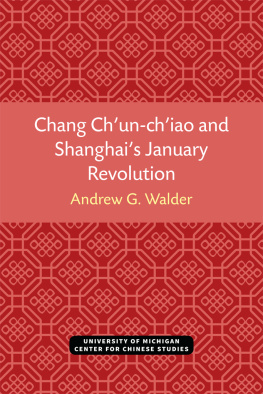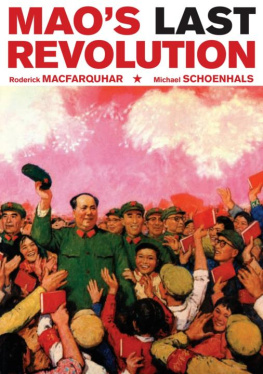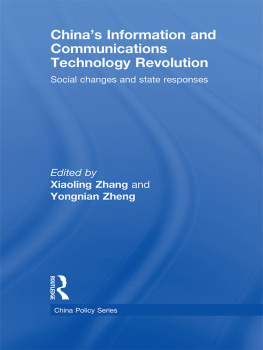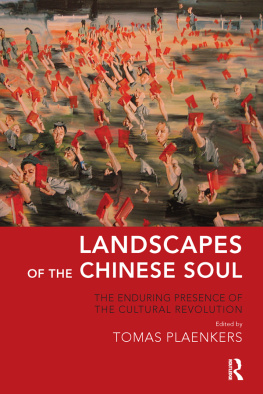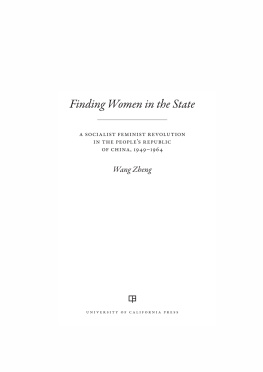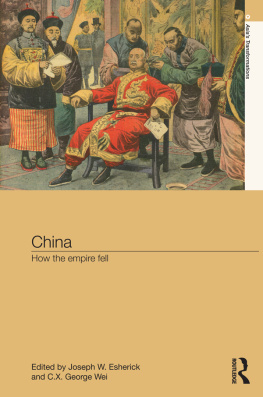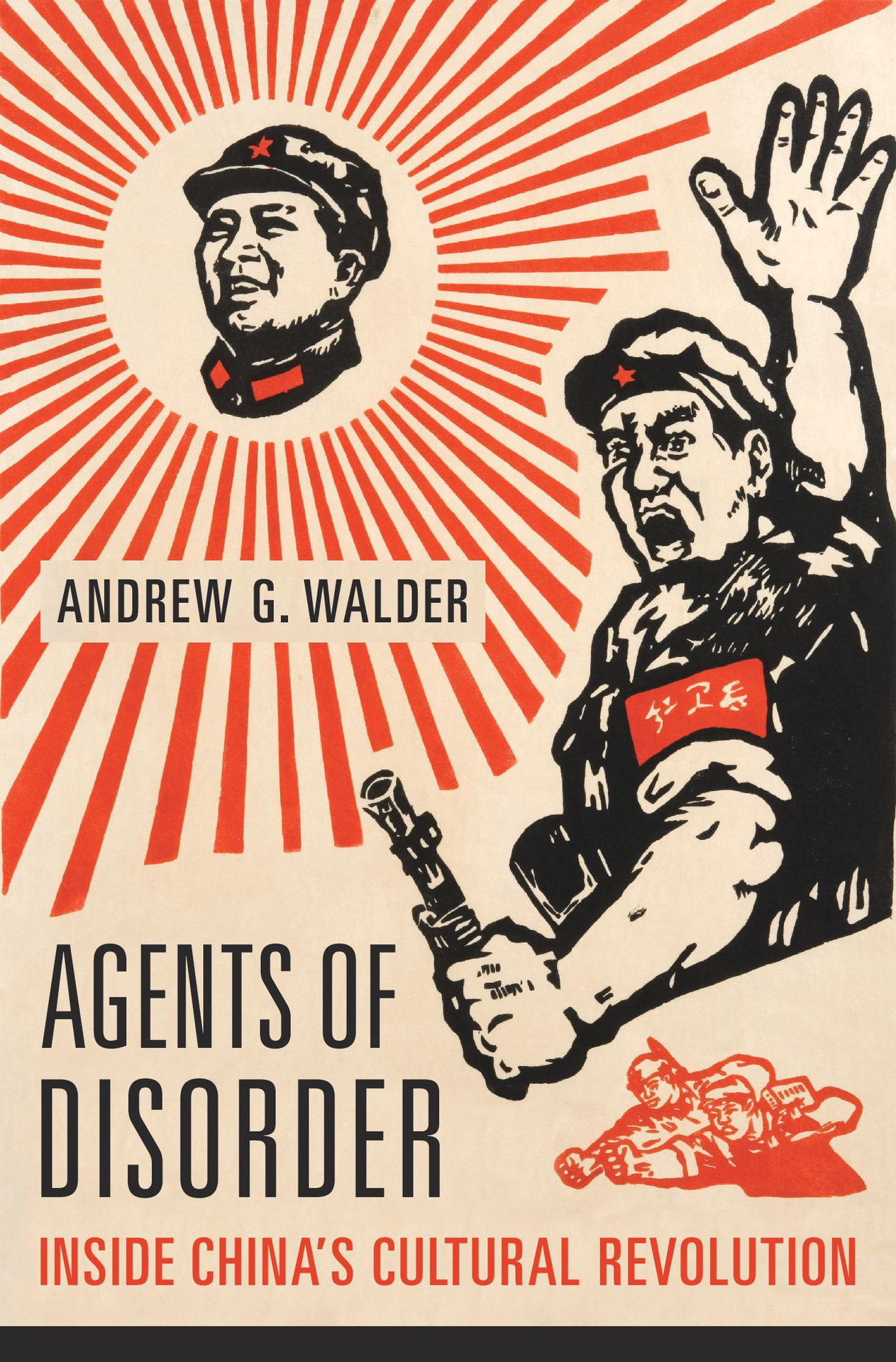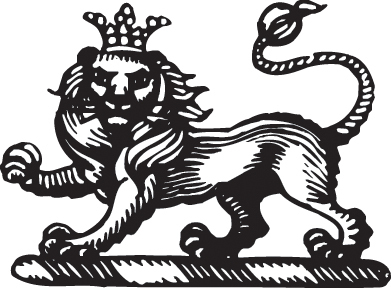AGENTS OF DISORDER
INSIDE CHINAS CULTURAL REVOLUTION
ANDREW G. WALDER
THE BELKNAP PRESS OF
HARVARD UNIVERSITY PRESS
CAMBRIDGE, MASSACHUSETTS
LONDON, ENGLAND | 2019
Copyright 2019 by the President and Fellows of Harvard College
All rights reserved
Cover art: Whoever Opposes Chairman Mao Will Have His Dog Head Smashed In! Red Guards of the Capital Bloody Bayonet Editorial Committee, February 1968 by Chinese School. Private Collection. The Chambers Gallery, London.
Cover Design: Annamarie McMahon Why
978-0-674-23832-9 (hardcover : alk. paper)
978-0-674-24364-4 (EPUB)
978-0-674-24365-1 (MOBI)
978-0-674-24363-7 (PDF)
The Library of Congress has cataloged the printed edition as follows:
Names: Walder, Andrew G. (Andrew George), 1953 author.
Title: Agents of disorder : inside Chinas Cultural Revolution / Andrew G.Walder.
Description: Cambridge, Massachusetts : The Belknap Press of Harvard University Press, 2019. | Includes bibliographical references and index.
Identifiers: LCCN 2019010124
Subjects: LCSH: ChinaHistoryCultural Revolution, 19661976. | ChinaPolitics and government19491976. | Political persecutionChinaHistory20th century.
Classification: LCC DS778.7 .W325 2019 | DDC 951.05 / 6dc23 LC record available at https://lccn.loc.gov/2019010124
To the memory of Barrington Moore, Jr.
CONTENTS
IT WAS NEVER MY intention to become a historical sociologist. My interest in the upheavals of Chinas Cultural Revolution was first sparked when I was an undergraduate in the early 1970s. At the time they were very recent events. The startling transformations of the post-Mao era diverted my attention away from this earlier period of upheaval, as they did virtually every other student of contemporary China. In recent years I have returned to this long-neglected subject, and find that I have become a historical sociologist largely through procrastination. It is fortunate that I delayed serious engagement with this topic, because there now are vastly more research materials on these events than were available to researchers some decades ago.
The seeds for this particular study were planted in the late 1970s, when I was a graduate student in the University of Michigans Department of Sociology. For several years, I occupied a desk at the Center for Research on Social Organization, housed in a somewhat dilapidated former elementary school, which became for a period my primary intellectual home. The Centers director, Charles Tilly, led a large research team gathering data on collective protest from microfilms of old British and French newspapers, coding them into what at the time was called a machine-readable database. Tilly was then a leading figure in quantitative historical sociology, and also part of a nascent intellectual movement that reshaped the study of collective action and popular protest. Other major figures in this and related effortsWilliam Gamson, Jeffery Paige, and Mayer Zaldalso occupied offices in the Center, along with graduate students engaged in research on political conflict in different times and places. The Centers bag lunches, workshops, speaker series, and conversations over (terrible) coffee made for an exciting intellectual atmosphere, and were as important in my graduate education as the formal coursework.
I originally decided to specialize in the study of China because of a deep interest in the upheavals of the Cultural Revolution. This was a subject close to the heart of intellectual activity at the Center, and I constantly thought about the political conflicts in late 1960s China through theoretical lenses prevalent at the Center. Unfortunately, during those years China was closed to scholars, and documentation about the conflicts of the period was unavailable. I could only dream of pursuing the analysis of Chinas late-1960s upheaval in the fashion then common at Michigan.
My fascination with this phase of the Chinese revolution never waned. As China opened up in the 1980s, the regime began to examine critically its recent history. During this process, a flood of new information was released, reviving my interest in the conflicts of the period. Early in the post-Mao era, the Chinese government mandated the publication of local annals, many of which contained surprisingly detailed accounts of political events during the Cultural Revolution. Mindful of the potential of these materials for the systematic analysis of rebellion and repression, I began to photocopy sections of annals that contained information about political events. My collection effort accelerated as more local annals were published, making near-complete coverage of the country a realistic goal.
By the time that I joined Stanfords faculty in 1997, my collection included some two-thirds of all cities and counties in China. While the photocopying continued in libraries in Hong Kong, the United States, and occasionally China, I employed a handful of graduate students in trial efforts to code these materials into a database. This work culminated in a concentrated final effort funded by a grant from the National Science Foundation in 2009 that completed a data set covering all but a few dozen counties in the country, and that contains information about close to 34,000 political events in 2,246 cities and counties. This data set, along with the most detailed of the narrative accounts on which it is based, is the primary foundation for this book.
Here I have made a conscious effort to look at this subject primarily through the eyes of social scientists who specialize in the study of rebellion and collective action. My aim is not solely to contribute new historical knowledge and novel interpretations of these still-obscure upheavals, although I am forced to address yawning gaps in the historiography of the period. I also hope to wring from my analysis of these events a set of ideas that will contribute to the way that social scientists analyze phenomena like rebellion and repression. Chinas Cultural Revolution was highly idiosyncratic, and in many ways historically unique, but it was driven by generic processes that have been observed in different guises in a wide variety of historical settings. My purpose is to lay bare these underlying processes and identify the general processes in the particular.
Barrington Moore, Jr., was one of the undisputed masters of historical sociology, and he was vitally interested in the social sources of political phenomena. His work on the social origins of dictatorship and democracy inspired generations of scholars across a number of disciplines. Quite by chance, during my years at Harvard more than twenty years ago, we formed a close friendship based on shared tastes in academic subjects and sailing excursions out of Salem harbor. Like many scholars of his generation, for him the question of how groups mobilized for political action was distinctly secondary to the more fundamental question of why they formed certain political orientations. This question has receded very much to the background in current work on political movements, especially in sociology. In some ways this book is a throwback to the preoccupations of an earlier generation. Both out of admiration for his intellectual accomplishments and affection for a departed friend, I dedicate this book to Barrys memory.
IN THE SUMMER OF 1966, the Peoples Republic of China was approaching the seventeenth anniversary of its founding. Taking power in October 1949 after a two-decade guerrilla insurgency and three-year civil war, the Chinese Communist Party subsequently built one of the most powerfully centralized revolutionary regimes in modern history. Yet within months of this anniversary, the civilian structures of this party-state were on the brink of collapse. Several of the largest cities were paralyzed by street battles between factions of rebel workers that disrupted rail transport and large state enterprises. Soon afterward, a wave of power seizures toppled local governments, spurring the dispatch of the armed forces to stabilize new structures of power. This, in turn, ushered in eighteen months of even more destructive civil disorder and violent factional warfare, which in many regions resembled civil war. A tenuous order was finally imposed near the end of 1968, placing most regions under a harsh regime of military control. When the dust finally cleared in 1969, close to 1.6 million people had died in the upheaval and the suppression campaigns through which political order was rebuilt. What forces generated this remarkable upheaval, and how did such a powerfully centralized state unravel so rapidly?


